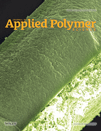Selective recognition of beta-cypermethrin by molecularly imprinted polymers based on magnetite yeast composites
Abstract
Magnetic nanoparticles were attached to yeast by co-precipitation reaction of FeCl3·6H2O and FeCl2·4H2O. Then, based on magnetite yeast composites (M@Y), the magnetic molecularly imprinted polymers (MMIPs) were synthesized for the selective recognition of beta-cypermethrin (PP321). MMIPs were characterized by scanning electron microscopy, X-ray diffraction, vibrating sample magnetometer, Fourier transform infrared analysis, thermogravimetric analysis, and elemental analysis. MMIPs exhibited uniform morphology and magnetic property (Ms = 17.87 emu/g) and thermal stability. Batch mode adsorption studies were carried out to investigate the specific adsorption equilibrium, kinetics, and selective recognition. The Langmuir isotherm model was fitted to the equilibrium data slightly better than the Freundlich model, and the adsorption capacity of MMIPs was 39.64 mg/g at 298 K. The kinetic properties of MMIPs were well described by the pseudo-second-order equation. Hydrogen bonds between methacrylic acid and PP321 were mainly responsible for the adsorption mechanism. The MMIPs prepared were applied to the separation of PP321 from experimental samples successfully. © 2013 Wiley Periodicals, Inc. J. Appl. Polym. Sci., 2013




